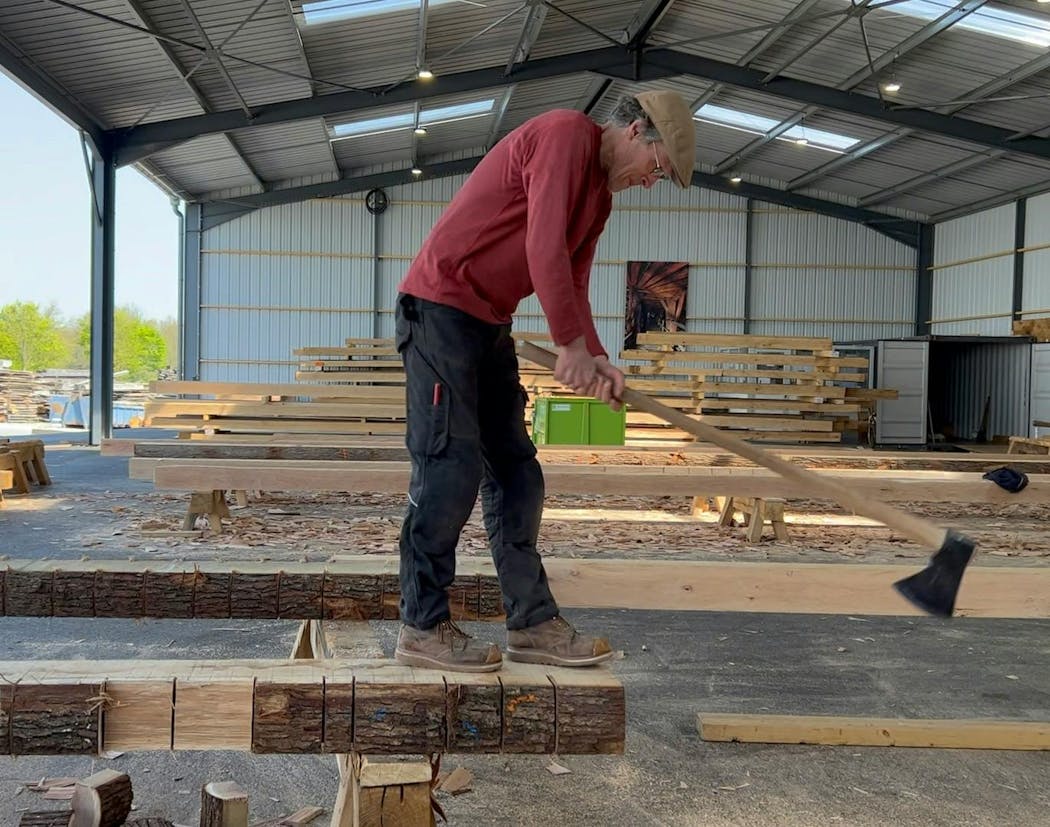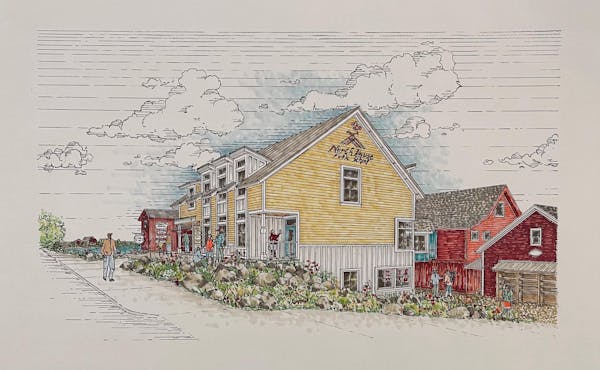GRAND MARAIS, MINN. — The fire started in the eaves of Notre Dame Cathedral in the center of Paris and onlookers from around the world watched as part of the 300-foot-high spire pitched, then collapsed into a sea of orange flames.
Some 4,000 miles away, Peter Henrikson, who lives with his wife, Amy, in a log home on the outskirts of Grand Marais on Lake Superior, saw the news reports on April 15, 2019. He had never been to the landmark and he didn't imagine he would ever go there.
But he knew about how it had been built — it's his area of expertise.
"I knew that the timber frame roof structure, a good portion of it being original from the Middle Ages, was one of the big iconic medieval timber frames in Europe," he said during a recent visit to his home near the Gunflint Trail.
Henrikson, 62, has been working with wood for decades and timber framing for the past 25 and log building before that. He learned his craft with power tools but is in a relatively small world of those who prefer to work without electricity. He is interested in the hands-on history of the tradition, he said.
Much of the cathedral's roof was destroyed in the blaze, but firefighters were able to keep it from leveling the more than 800-year-old landmark. Its two towers and much of the art and relics kept there, including the Crown of Thorns of Christ, were saved. The fire was ruled an accident, but there still is no official cause. Both faulty wiring and a carelessly tossed cigarette have been considered as possibilities. The structure was undergoing a massive, renovation project at the time.
The French government's promise that the structure would rise again came swiftly.
"We will rebuild the cathedral," President Emmanuel Macron said that day.
In the months after the historic fire, there was a national debate about whether there would be a modern rebuild or if it would return to its original likeness. New ideas ranged from a roof made of stained glass to a shiny golden spire shaped like the flames from the fire that destroyed it.
In the summer of 2020, the Élysée Palace issued a definitive statement.
"The president of the republic has become convinced of the need to restore Notre-Dame de Paris in the most consistent manner possible to its last complete, coherent, and known state."
Four years later, Henrikson was brought on for the assignment to help in a traditional rebuild of the cathedral's roof.
"It was one of those things," he said. "How can I pass this up?"
***
In early 2023, Henrikson joined Ateliers Perrault in Saint-Laurent-de-la-Plaine about three hours from Notre-Dame. The crew was charged with building 13 trusses for the choir and apsis areas.
"It was all hand-hewn timber and a lot of really interesting joint work because it was the earliest part of the cathedral that was built," he said. "And they were, in some ways it seemed, experimenting a little to figure it out."
Henrikson already had helped to prove this traditional technique was possible. In 2021, he worked with the nonprofit Handshouse Studio in Washington, D.C., to build the likeness of one of the cathedral's oldest trusses using only traditional tools. Fifty volunteers worked for 10 days to erect the 7,500-pound wooden triangle structure at the Catholic University of America.
In France, Henrikson spent his time alongside other independent contractors brought on specifically to tend to the timber.
They started with a raw oak log, squared it off and cut notches into it. Then they knocked wood off with a large ax — in this case forged specifically for the work on the cathedral. Another smaller ax was used to smooth the wood to a finer finish. Later he shifted to joinery work, connecting the boards.
His sister-in-law Judy Griesedieck caught him standing on top of a long trunk as he swung an ax earlier this year during a visit.
"It's a lost art," she said of his work.
Henrikson worked 39 hours a week for the six months he was there, but a flexible schedule kept workers from burning out. Both coffee breaks and time off were easy to secure. Lunches included dessert and espresso and spanned more than an hour. He was paid for his work and accrued vacation time. He said he traveled to the Swiss Alps and Norway during his stay.
Though the crew was working far from Notre Dame, they were able to tour the cathedral in April. By then much of the cleanup was done, and work had been completed on the stone vaults. The workers climbed on the scaffolding inside and outside of the building. The cathedral's famous rose window was a highlight, Henrikson said.
"We were looking straight at it," he said, rather than peering up from ground level.
***
The wooden frame of a new spire went up recently at Notre Dame Cathedral, matching the one originally built in 1859. Roofers soon will cover it with lead, according to an update from Friends of Notre-Dame de Paris. A crane placed a new golden rooster at the top — this one with relics tucked inside along with the names of some of the 2,000 people who have helped in the rebuild.
Macron has said the project is on pace to reopen to visitors in a year, in December 2024.
Henrikson said he receives updates from his friends who still are working in France. He won't make it to the grand reopening, but he has been promised a tour in the summer of 2025.
Back at home he is a teacher, a builder and a designer. He worked with the monks at St. John's University on projects for the abbey's arboretum and with students at St. Olaf College to design and build a chime tower and new Art Barn. He collaborates with high school students on annual projects, including building a scorers nest overlooking the Silver Bay football field in 2017 and a covered bridge for the Grand Marais Municipal Campground in 2013.
He returned to town just in time to work on a new central structure at the North House Folk School — part of a $5 million expansion project.
He installed a single part of his French experience back in his home life.
"We did have to buy an espresso machine," he said.

Crime on Metro Transit trains and buses dips by nearly 8%
Trucker was watching Netflix on phone when he caused I-35 crash that killed couple, charges say

Prep Athletes of the Week: Slender pitcher heavy on importance

Gun safety bills may hinge on one senator's fate despite House support, likely passage




